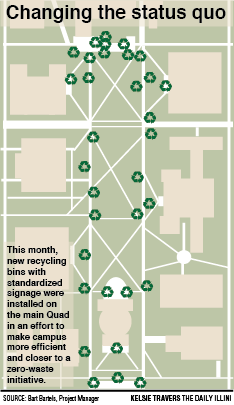New campus recycling bins aim to bring waste awareness

April 30, 2015
In an effort to make campus more eco-friendly and closer to a zero-waste initiative, 20 new recycling bins with standardized signage were installed on the Quad this month, making 30 total recycling/landfill stations.
The project was completed by the Illinois Sustainable Technology Center (ISTC). According to the project’s leader Bart Bartels, technical assistance engineer at ISTC, the center makes recommendations and completes projects aiming to reduce waste emissions on campus.
This zero-waste initiative is part of the goal of the Illinois Climate Action Plan (iCAP), the University’s mission to make campus carbon neutral by 2050.
“Zero-waste is basically sending close to nothing to the landfill … It’s usually at least 90 percent of your materials are either recycled, composted or reused,” Bartels said.
After conducting a series of surveys last year, ISTC found there was a common misconception about campus recycling. The surveys found that many students believe all materials thrown into disposal bins on campus are eventually sorted by the Waste Transfer Station. According to Bartels, that is only the case in some locations.
Get The Daily Illini in your inbox!
To try and reverse this misconception, 20 recycling bins with new signage were purchased and installed on the Quad on April 9. The lids on the bins now distinguish recycling (bottles and cans) with a blue lid and landfill with a black lid.
Bartels said the new signage allows each person to make a conscious choice when they throw something away. It also standardizes the signage throughout campus. The signage for recycling is currently different throughout the C-U community as well.
“Eventually, I’d like to have that standardized throughout the whole community, so that no matter where you are, it’s easy to recognize what should go in the bins,” Bartels said.
He said it should now be easy to tell what is recycling and what is landfill.
Adriana Noboa, freshman in Engineering, said she uses the new recycling bins often.
“I’m pretty sure people use them correctly,” she said. “It’s a pretty good service to have around.”
The new bins are essentially a pilot project to see if these methods can be replicated throughout campus. After sorting the waste in the bins to see what materials were going in after they were installed, Bartels said they found that very little recyclable material was going into the landfill bins.
“So knowing that contamination rates are low in the landfill bins, we may be able to change the process,” Bartels said. “Instead of sending those landfill bins to the Waste Transfer Station to be sorted, we can just send them directly to the landfill, and we can focus on collecting more recycling.”
Bartels said this process — which starts with each person’s decision — would make it more efficient for both the consumer as well as the Waste Transfer Station employees.
Tracy Osby, team member for the project and coordinator of campus waste management, said the new recycling bin project affects the Waste Transfer Station’s workflow.
“It makes sorting a bit easier,” he said.
Bartels said he hopes the contamination levels are so low that they don’t have to sort through any landfill bins, which would free up time at the Waste Transfer Station.
“If that happens, we can then justifiably expand the program because they will have more time. The labor cost of sorting materials will be lower,” Bartels said. “And because we’re getting a cleaner product, we can actually sell those cans and bottles that we’re collecting, so that money could actually go back into the program.”
According to the iCAP website, over 50 percent of the University’s waste is diverted from landfills. By 2020, they hope to divert 75 percent.
The recycling bin project, funded in part by Facilities and Services, the Student Sustainability Committee and ISTC, costs around $22,000 total, with the bins costing $12,000. Bartels said that Facilities and Services painted and sandblasted the bins and placed them on the Quad.
Beyond this pilot program, ISTC has more plans for continuing the University’s zero-waste initiative, including starting a Styrofoam recycling program, a nitro glove (used in dining halls and labs) recycling program, and a repeat of their Zero Waste Game Day, which took place at the 2014 Illinois Homecoming football game. Bartels said over 60 percent of the waste produced that day was either composted or recycled.
Yet, according to Bartels, there is still much to be done to reach the zero-waste and carbon neutral goals.
“We’re making improvements, but we have a long way to go,” he said.






